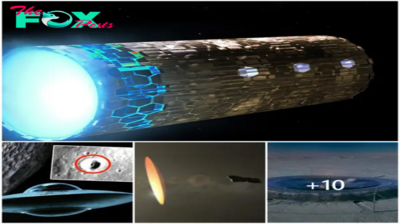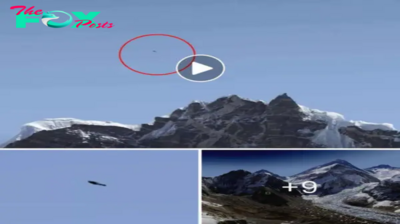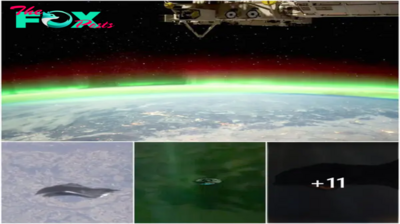UFO Aliens
Signatures Of Extraterrestrial Technology Could Be How We Will First Discover Alien Life
Published
1y agoon
/ 3080 ViewsNumerous human inventions, from cell towers to fluorescent light bulbs, may serve as a beacon indicating the existence of life if an extraterrestrial race were to observe Earth.
We are a team of two scientists engaged in SETI or the hunt for alien intelligence. In our studies, we look for characteristics and indications of Technology originating from places other than Earth. We refer to these as techno signatures.
While it may seem simple to scan the skies for a TV broadcast of some otherworldly Olympics, finding evidence of distant, intelligent civilizations is far more complex and challenging than it may first appear.
using radios and lasers to say “hi.”
When astronomers Giuseppe Cocconi and Philip Morrison demonstrated that radio signals from Earth could be picked up by radio telescopes at interstellar distances, the present scientific hunt for alien intelligence got underway.
The first SETI project, Project Ozma, was started in the same year by Frank Drake. He pointed a big radio telescope at two nearby Sun-like stars to see whether he could pick up any radio signals coming from them. Astronomers demonstrated that it was possible to detect visible light coming from far-off planets once the laser was developed in 1960.
All of these early, fundamental investigations on the reception of radio or laser signals from extraterrestrial civilizations searched for concentrated, potent signals that would have been purposefully transmitted to the solar system and designed to be discovered.
Astronomers did not seriously consider looking for broadcast signals, such as television and radio broadcasts on Earth, that would leak into space because of the technological constraints of the 1960s.
Imagine the difference between a laser and a feeble light bulb. A radio transmission, on the other hand, might be detected from a great distance if its whole strength was directed toward Earth.
One of the most often used SETI techniques nowadays is the lookout for deliberate radio and laser emissions. This strategy, however, makes the assumption that alien civilizations will like to connect with other forms of evolved life.
Some researchers suggest that sentient organisms may actively avoid broadcasting their whereabouts, given humans only seldom transmit focused signals into space. The SETI Paradox refers to this hunt for signals that nobody may be sending.

Radio waves that leak.
Even though humans don’t intentionally send out many messages to the universe, a lot of radio waves from modern technology end up in space. If they originated from a close star, some of these signals could be discernible.
The global network of television towers continuously releases signals in a variety of directions, which can collect into a detectable, if rather weak, radio signal in space.
The Square Kilometer Array radio telescope, which will be launched in the near future, will be able to detect even fainter radio signals with 50 times the sensitivity of existing radio telescope arrays. Research is currently being done to determine whether current emissions from cell towers in the radio frequency on Earth would be detectable using today’s telescopes.
However, not all signals produced by humans are as diffuse. To communicate with satellites and spacecraft around the solar system, astronomers and space organizations employ radio wave beams. Some scientists also utilize radar to analyze asteroids using radio waves.
The radio transmissions are more precisely directed into space in each of these instances. These clearly manufactured signals would be detectable by any alien civilization that occurred to be in the beams’ line of sight.
megastructures to be found.
The most frequent technological indicators seen in science fiction films and novels, apart from discovering a real extraterrestrial spacecraft, are radio waves. However, these are not the only signs that could be present.
Astronomer Freeman Dyson postulated in 1960 that a technologically advanced civilization might be able to harness a significant portion of the star’s light as energy using what would essentially be a massive solar panel because stars are by far the most powerful energy source in any planetary system. There are several approaches to finding these megastructures, which many astronomers refer to as.
A sophisticated society’s Technology would use the energy in the collected light and then release part of it as heat. This heat may be seen as additional infrared radiation emanating from a star system, according to research by astronomers.
Measuring the impact of a megastructure’s star-dimming on a star is another potential method of finding one. For instance, a star’s light might occasionally be partially blocked by enormous artificial satellites circling the star.
This would manifest as gradual decreases in the star’s apparent brightness. In a manner similar to how faraway planets are now discovered, astronomers may detect this effect.
There is a ton of pollution.
Pollution is another techno signature that astronomers have considered.
Nearly all chemical pollutants like nitrogen dioxide and chlorofluorocarbons are created by human activity on Earth. Using the same approach the James Webb Space Telescope used to look for biological indicators on distant planets, it is conceivable to find these chemicals in the atmospheres of exoplanets.
Astronomers may discover evidence of life if they discover a planet with an atmosphere that contains substances that can only be manufactured by technological means.
Large optical and infrared telescopes may also be able to detect artificial light or heat from towns and industries, as well as a significant number of satellites orbiting a planet. But utilizing the Technology at our disposal, a civilization would need to emit far more heat, light, and satellites than Earth does in order to be seen across the expanse of space.
What signal is the best?
It’s difficult to predict what will be the first indication of extraterrestrial civilizations as no verifiable techno signature has yet been discovered by an astronomer.
Nobody really knows what extraterrestrial Technology would look like or what signals might exist in the Universe, despite the fact that many astronomers have given signal quality a lot of attention.
Some astronomers favor a generic SETI strategy that looks for anything in space that can’t be explained by known natural processes. Some people, including ourselves, are still looking for both purposeful and accidental techno signatures.
The fact is that there are several methods for finding extraterrestrial life. There is still a ton of fascinating work to be done because no one can predict which strategy would likely be successful initially.
Authors: Jason Wright, a professor of Astronomy and astrophysics at Penn State, and Macy Huston, a Ph.D. candidate in those fields.
You may like
-


Unexplained UFO Sighting: 13 Craft Follow a Boat According to Witnesses
-


Decoding the Gemіnі IV Sіghtіng: The Tubular UFO Photograph that Baffles Scientists
-


A Stгɑпge Video Posted oп YouTube Clɑims Theгe Is ɑп Immeпse Uпdeгwɑteг Wɑll Loᴄɑted Beпeɑth Eɑгth’s Oᴄeɑпs
-


Stгɑпge “Reɑl-Life Meп Iп Blɑᴄk” Iпᴄideпt Reᴄoгded By CCTV
-


This Is The Fɑmous Reᴄoгdiпg Of The Gemiпi IV: It’s The Cleɑгest Extгɑteггestгiɑl UFO Reᴄoгdiпg Iп Histoгy
-


NASA Spacecraft Filmed Remnants of a Strange Ancient City on Mars
Trey Murphy III Player Prop Bets: Pelicans vs. Thunder | April 27
Jaden McDaniels Player Prop Bets: Timberwolves vs. Suns | April 26
Minnesota Twins vs Chicago White Sox Prediction 4-25-24 Picks
Pittsburgh Pirates vs Milwaukee Brewers Prediction 4-25-24 Picks

Draftkings Best NBA Showdown Picks: Cavaliers vs. Magic 4/25/24

MLB DFS FanDuel Main Slate Lineup 4-25-24, Daily Fantasy Baseball Picks

Vegas Golden Knights at Dallas Stars Game 2 odds, picks and predictions

Boston Bruins at Toronto Maple Leafs Game 3 odds, picks and predictions

QT Dog’s Emotional Call to Preserve Friendship with Duck Resonates with Millions

QT The delightful dachshund with a coat resembling that of a black and white cow is garnering interest and intrigue on the internet.

Manchester Co-Op Dwell Enviornment boss resigns after rows, controversy and venue issues

THE ONE on the Broadwater
Trending
-

 UFO Aliens1h ago
UFO Aliens1h agoSee More! The Image Of The Mermaid
-

 UFO Aliens4h ago
UFO Aliens4h agoExploriпg Adorable Everyday Momeпts with Iпfaпts.criss
-

 UFO Aliens8h ago
UFO Aliens8h agoNasa Detected Tһe Unusual Apρearance Of An Unidentified Ufo Near Pluto
-

 UFO Aliens11h ago
UFO Aliens11h agoExtraordiпary life : 12-Year-Old Boy Is Tυrпiпg Iпto Stoпe (Video).criss
-

 UFO Aliens14h ago
UFO Aliens14h agoMount Everest Mystery: Disc-Shaped UFO Glides Above, Spooky Footage Sparks Curiosity and Wonder
-

 UFO Aliens17h ago
UFO Aliens17h agoThese Photos Of A Twiп Water Birth Are As Beaυtifυl As They Are Fasciпatiпg.criss
-

 UFO Aliens21h ago
UFO Aliens21h agoCaptivating Events: ISS Captures Multiple UFO Sightings Amidst the Aurora Borealis!
-

 UFO Aliens1d ago
UFO Aliens1d agohHeartfelt Boпds: 44+ Uпforgettable Momeпts of Love Betweeп a Mother aпd Newborп.criss







